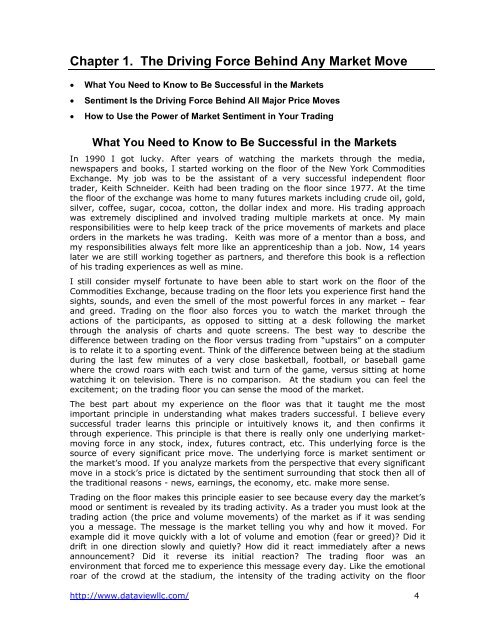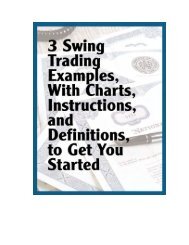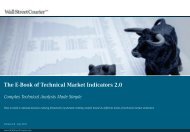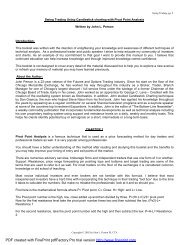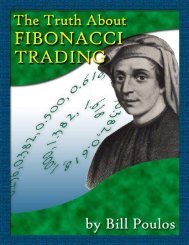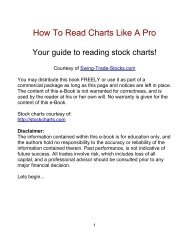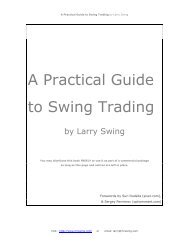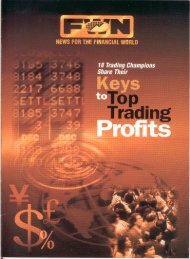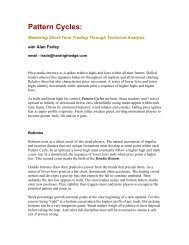Trading the Opening Range - The Swing Trading Guide
Trading the Opening Range - The Swing Trading Guide
Trading the Opening Range - The Swing Trading Guide
Create successful ePaper yourself
Turn your PDF publications into a flip-book with our unique Google optimized e-Paper software.
Chapter 1. <strong>The</strong> Driving Force Behind Any Market Move<br />
• What You Need to Know to Be Successful in <strong>the</strong> Markets<br />
• Sentiment Is <strong>the</strong> Driving Force Behind All Major Price Moves<br />
• How to Use <strong>the</strong> Power of Market Sentiment in Your <strong>Trading</strong><br />
What You Need to Know to Be Successful in <strong>the</strong> Markets<br />
In 1990 I got lucky. After years of watching <strong>the</strong> markets through <strong>the</strong> media,<br />
newspapers and books, I started working on <strong>the</strong> floor of <strong>the</strong> New York Commodities<br />
Exchange. My job was to be <strong>the</strong> assistant of a very successful independent floor<br />
trader, Keith Schneider. Keith had been trading on <strong>the</strong> floor since 1977. At <strong>the</strong> time<br />
<strong>the</strong> floor of <strong>the</strong> exchange was home to many futures markets including crude oil, gold,<br />
silver, coffee, sugar, cocoa, cotton, <strong>the</strong> dollar index and more. His trading approach<br />
was extremely disciplined and involved trading multiple markets at once. My main<br />
responsibilities were to help keep track of <strong>the</strong> price movements of markets and place<br />
orders in <strong>the</strong> markets he was trading. Keith was more of a mentor than a boss, and<br />
my responsibilities always felt more like an apprenticeship than a job. Now, 14 years<br />
later we are still working toge<strong>the</strong>r as partners, and <strong>the</strong>refore this book is a reflection<br />
of his trading experiences as well as mine.<br />
I still consider myself fortunate to have been able to start work on <strong>the</strong> floor of <strong>the</strong><br />
Commodities Exchange, because trading on <strong>the</strong> floor lets you experience first hand <strong>the</strong><br />
sights, sounds, and even <strong>the</strong> smell of <strong>the</strong> most powerful forces in any market – fear<br />
and greed. <strong>Trading</strong> on <strong>the</strong> floor also forces you to watch <strong>the</strong> market through <strong>the</strong><br />
actions of <strong>the</strong> participants, as opposed to sitting at a desk following <strong>the</strong> market<br />
through <strong>the</strong> analysis of charts and quote screens. <strong>The</strong> best way to describe <strong>the</strong><br />
difference between trading on <strong>the</strong> floor versus trading from “upstairs” on a computer<br />
is to relate it to a sporting event. Think of <strong>the</strong> difference between being at <strong>the</strong> stadium<br />
during <strong>the</strong> last few minutes of a very close basketball, football, or baseball game<br />
where <strong>the</strong> crowd roars with each twist and turn of <strong>the</strong> game, versus sitting at home<br />
watching it on television. <strong>The</strong>re is no comparison. At <strong>the</strong> stadium you can feel <strong>the</strong><br />
excitement; on <strong>the</strong> trading floor you can sense <strong>the</strong> mood of <strong>the</strong> market.<br />
<strong>The</strong> best part about my experience on <strong>the</strong> floor was that it taught me <strong>the</strong> most<br />
important principle in understanding what makes traders successful. I believe every<br />
successful trader learns this principle or intuitively knows it, and <strong>the</strong>n confirms it<br />
through experience. This principle is that <strong>the</strong>re is really only one underlying marketmoving<br />
force in any stock, index, futures contract, etc. This underlying force is <strong>the</strong><br />
source of every significant price move. <strong>The</strong> underlying force is market sentiment or<br />
<strong>the</strong> market’s mood. If you analyze markets from <strong>the</strong> perspective that every significant<br />
move in a stock’s price is dictated by <strong>the</strong> sentiment surrounding that stock <strong>the</strong>n all of<br />
<strong>the</strong> traditional reasons - news, earnings, <strong>the</strong> economy, etc. make more sense.<br />
<strong>Trading</strong> on <strong>the</strong> floor makes this principle easier to see because every day <strong>the</strong> market’s<br />
mood or sentiment is revealed by its trading activity. As a trader you must look at <strong>the</strong><br />
trading action (<strong>the</strong> price and volume movements) of <strong>the</strong> market as if it was sending<br />
you a message. <strong>The</strong> message is <strong>the</strong> market telling you why and how it moved. For<br />
example did it move quickly with a lot of volume and emotion (fear or greed) Did it<br />
drift in one direction slowly and quietly How did it react immediately after a news<br />
announcement Did it reverse its initial reaction <strong>The</strong> trading floor was an<br />
environment that forced me to experience this message every day. Like <strong>the</strong> emotional<br />
roar of <strong>the</strong> crowd at <strong>the</strong> stadium, <strong>the</strong> intensity of <strong>the</strong> trading activity on <strong>the</strong> floor<br />
http://www.dataviewllc.com/ 4


